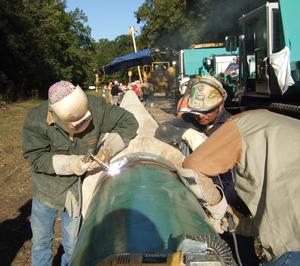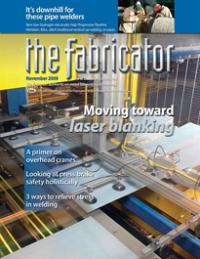- FMA
- The Fabricator
- FABTECH
- Canadian Metalworking
Categories
- Additive Manufacturing
- Aluminum Welding
- Arc Welding
- Assembly and Joining
- Automation and Robotics
- Bending and Forming
- Consumables
- Cutting and Weld Prep
- Electric Vehicles
- En Español
- Finishing
- Hydroforming
- Laser Cutting
- Laser Welding
- Machining
- Manufacturing Software
- Materials Handling
- Metals/Materials
- Oxyfuel Cutting
- Plasma Cutting
- Power Tools
- Punching and Other Holemaking
- Roll Forming
- Safety
- Sawing
- Shearing
- Shop Management
- Testing and Measuring
- Tube and Pipe Fabrication
- Tube and Pipe Production
- Waterjet Cutting
Industry Directory
Webcasts
Podcasts
FAB 40
Advertise
Subscribe
Account Login
Search
No cracking under pressure for pipeline contractor
A new stick electrode helps to improve productivity, reduce costs, and beat construction deadline
- November 3, 2009
- Article
- Consumables

Figure 1 Traditionally, welders working with the SMAW process used low-hydrogen electrodes and welded vertical-up. New electrodes, however, enable welding to be done vertical-down, a much more welder-friendly process that helps to increase productivity. Photos courtesy of The Lincoln Electric Co.
Not since the embargo of the 1970s has the U.S. been more preoccupied with the price of oil. Motorists still remember when gas prices climbed to the $4-per-gallon range about two years ago when the oil prices jumped over $100 per barrel, and they have their eyes peeled for a similar spike. Economists watch it closely because they know when oil prices start to climb that it's a good sign that the commodity is more in demand and the global economy is revving up. Metal fabricators know that when oil prices hit about $70 per barrel that the economic climate is good for oil exploration, and demand for metal goods for oil rigs, pipelines, and other infrastructure will follow.
Seemingly, everyone has an interest, even if their motivations differ. What they all will agree on, however, is that any chance to maximize existing energy sources in the U.S. should be pursued vigorously. Demand for oil isn't going to disappear overnight, and anything that can be done to reduce the need to rely on foreign sources meets the objectives of most domestic consumers and their elected officials.
That's where a lesson in enhanced oil recovery (EOR) is necessary. EOR is a broad term used to describe several methods that increase the amount of oil that can be extracted from an oil field. It's estimated that EOR processes can result in the recovery of up to 30 to 60 percent of a field's original oil.
Gas injection is the most common method to displace this hard-to-retrieve oil. CO2 is most commonly used, but natural gas and nitrogen are used as well.
The Emergence of CO2 Pipelines
It's important to understand the role CO2 plays in enhanced oil recovery. The CO2 is transported through a pipeline in dense phase from a CO2 source to an injection well. The CO2 is injected into the oil reservoir, where it mixes with oil droplets, expands them, and moves them to producing wells. The CO2 also reduces the viscosity of the oil, which helps remove it from the oil-bearing formation.
The production stream consists of oil, water, and CO2. On the surface, production components are separated. The oil is sold; produced water is disposed of; and the CO2 is recycled and reinjected into the reservoir, where it can be sequestered.
In the future CO2 EOR should become an important process, supporting carbon capture and sequestration while producing crude oil that would not otherwise be produced.
Of course, the catch is that CO2 does not exist naturally in a large concentration in many areas of the U.S. In fact, most of the largest natural underground CO2 deposits are in the West, in places like Wyoming and New Mexico. That's why the construction of a CO2 pipeline is critical to this type of tertiary oil recovery.
Meridian, Miss.-based Progressive Pipeline Inc. is familiar with these types of critical construction projects. In 2008 it constructed an 80-mile pipeline made of 24-inch-diameter API 5L X80 steel with a wall thickness of 0.469 inch for Denbury Onshore LLC, a wholly owned subsidiary of Denbury Resources Inc., an oil and gas company with headquarters in Plano, Texas. Denbury happens to own the largest reserves of CO2 used for this type of oil recovery east of the Mississippi River. The deposits are located near Jackson, Miss., and the new pipeline runs from Tinsley, Miss., to Delhi, La.
This pipeline is designed to operate under a maximum pressure of 2,160 PSI. That's a lot of pressure, which makes the integrity of the welds critical. Use of low-hydrogen, vertical-down electrodes (see Figure 1) helped Progressive meet those quality standards, while simultaneously helping it achieve a 15 to 20 percent increase in productivity.
Why Is the Consumable Important?
High-strength steel enables gas pipelines to withstand higher operating pressures and achieve higher throughput. For example, actual pipeline operating pressure varies depending on many factors, including the diameter, wall thickness, and grade of pipe, but for the most part it is typically around 1,000 to 1,500 PSI. Using higher strength steel, such as going from X60 to X80, and keeping everything else the same results in a proportional increase in maximum allowable pressure, or in this case, 33 percent higher pressure. In fact, some of the newer high-strength steel pipelines operate around 2,000 PSI.
The high-strength steel also may allow for a reduction in wall thickness, which reduces costs associated with hauling and handling of material, as well as time spent welding the pipe. However, the move to higher-strength steels results in a greater susceptibility to weld metal hydrogen-assisted cracking (HAC).
HAC occurs when the arc energy interacts with the ambient air, partially ionizing the arc into hydrogen, which can be absorbed by the weld metal. This situation is exacerbated when the welding of these high-strength steels occurs in locations with relatively high humidity, such as Mississippi (see Figure 2).
Consumable manufacturers have focused on developing low-hydrogen vertical-down (LH-D) electrodes that address this weld quality challenge. Of course, this challenge has grown more complicated with the development of advanced materials.
Today high-strength steel pipe grades like X80 are widely used for long-distance transmission pipelines, but present a challenge for welding. In the past field girth welds on X70 and lower-strength grades were completed almost exclusively with cellulosic electrodes because of their low cost. However, with high-strength X80, cellulosic electrodes typically are used only for root and hot passes and are not used for fill passes, due to the increased risk of HAC.
The Electrode Benefits
Project Consulting Services Inc. (PCS), with headquarters in Metairie, La., served as construction manager for the project. It engaged Det Norske Veritas (DNV), whose Columbus, Ohio, office focuses on research, testing, and engineering, to help evaluate many of the commercially available welding options for the project. The DNV Columbus effort was managed by Bill Bruce, director of welding technology. Progressive furnished the welding services required to complete these evaluations. At the conclusion of the evaluation, DNV Columbus (formerly CC Technologies) recommended the use of Pipeliner® LH-D electrodes from Lincoln Electric. Denbury accepted this recommendation for use on the project.
"We had worked with Lincoln as they were developing the electrode and recognized the advantages it would provide to the project in terms of preventing hydrogen cracking," explained Brad Etheridge, welding engineer at DNV Columbus. "And with the vertical-down approach, they were likely to see an increase in productivity as well."
Traditionally, low-hydrogen electrodes are welded vertical-up, which is a slow process. Welders didn't have much choice in the past because the low-hydrogen electrodes have a very fluid slag. Welders tended to weld up so that they could build a slag shelf as they created the joint.
Changes in the amount and type of flux incorporated into the low-hydrogen electrodes changed the nature of the welding process, however. With the fluid slag being less of an issue, welders could weld vertical-down, which allowed for almost twice the deposition rate of vertical-up, significantly increasing productivity (see Figure 3).
Also, once opened, low-hydrogen electrodes usually need to be stored in heated ovens, which is difficult to manage in the field. The Lincoln electrodes are packaged in small, hermetically sealed, 10-pound steel cans, which in some instances may eliminate the need for rod ovens if they are used within four to eight hours.
Typically, these types of electrodes come in 50-lb. cans, so ovens are often called into service because a job rarely requires that many low-hydrogen electrodes in an eight-hour time frame.
To get a better idea how the LH-D electrodes were used, Korey Adams, assistant spread superintendent at Progressive, described the welding process for the Tinsley-Delhi pipeline. First, the pipe end bevels are cleaned. Then the pipe is preheated to 300 degrees F (150 degrees C), and the pipe ends are clamped together. An E6010 electrode is used for the open root pass with the shielded metal arc welding (SMAW) process, followed by an E9010-G hot pass. An E10045-P2 H4R low-hydrogen downhill electrode is used for the remaining fill and cap passes.
Progressive used Lincoln Electric consumables exclusively on this project: Fleetweld® 5P+ (E6010) for the root pass; Shield-Arc® 90 (E9010-G) for the hot pass; and Pipeliner LH-D100 (E10045-P2 H4R) for the fill and cap passes.
Chris Moody, P.E., project manager for Denbury, said that when they were considering the transition to the new electrode, they wanted to make sure that the production rate would be as good or better than a cellulosic weld procedure would produce.
"While the cost for the low-hydrogen vertical-down electrodes was higher than cellulosic electrodes, we've more than made up the cost difference with the increase in productivity," Moody said.
Before the start of the project, Progressive, PCS, and Denbury were expecting to be able to complete 50 joints per day with the LH-D electrodes. They were thrilled when the Progressive team hit 70 per day.
Reinforcing these strong numbers were low repair rates, with radiographic inspections detecting very few defects in the low-hydrogen vertical-down fill and cap passes.
Moody and Adams both said that the welders responded positively to the new electrode and saw no issues with its weldability. Adams noted, "Additionally, our welders saw noticeably easier starting with the electrode's tapered tip design, which allows for easy touch-start arc strikes."
Related Companies
subscribe now

The Fabricator is North America's leading magazine for the metal forming and fabricating industry. The magazine delivers the news, technical articles, and case histories that enable fabricators to do their jobs more efficiently. The Fabricator has served the industry since 1970.
start your free subscription- Stay connected from anywhere

Easily access valuable industry resources now with full access to the digital edition of The Fabricator.

Easily access valuable industry resources now with full access to the digital edition of The Welder.

Easily access valuable industry resources now with full access to the digital edition of The Tube and Pipe Journal.
- Podcasting
- Podcast:
- The Fabricator Podcast
- Published:
- 04/16/2024
- Running Time:
- 63:29
In this episode of The Fabricator Podcast, Caleb Chamberlain, co-founder and CEO of OSH Cut, discusses his company’s...
- Trending Articles
AI, machine learning, and the future of metal fabrication

Employee ownership: The best way to ensure engagement

Steel industry reacts to Nucor’s new weekly published HRC price

How to set a press brake backgauge manually

Capturing, recording equipment inspection data for FMEA

- Industry Events
16th Annual Safety Conference
- April 30 - May 1, 2024
- Elgin,
Pipe and Tube Conference
- May 21 - 22, 2024
- Omaha, NE
World-Class Roll Forming Workshop
- June 5 - 6, 2024
- Louisville, KY
Advanced Laser Application Workshop
- June 25 - 27, 2024
- Novi, MI


























